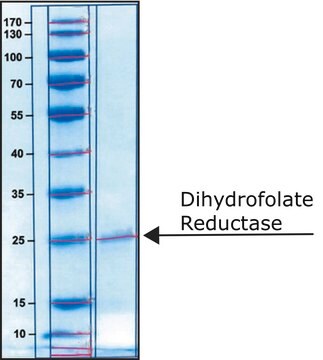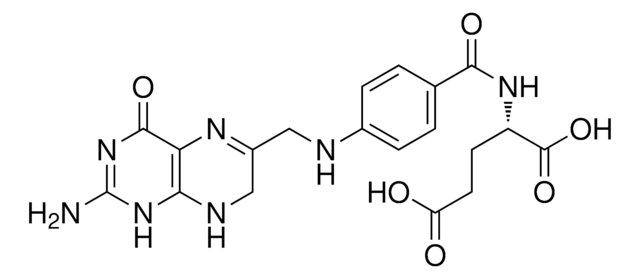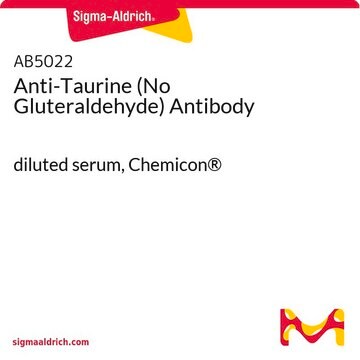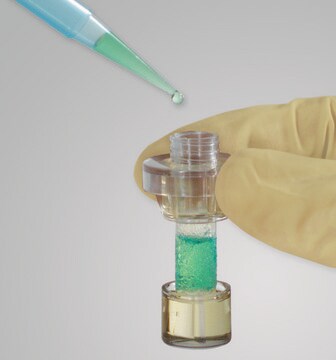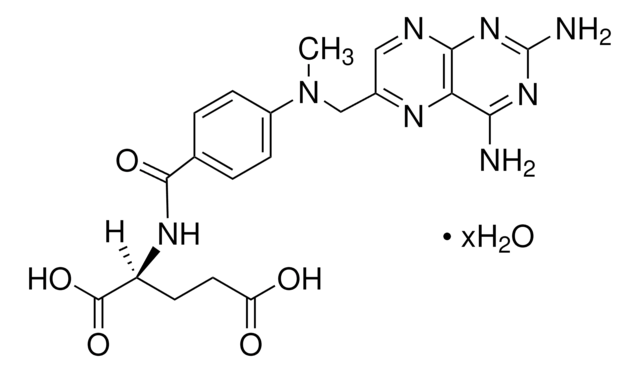CS0340
Dihydrofolate Reductase Assay Kit
1 kit sufficient for 50-100 tests
Synonyme(s) :
DHFR Assay Kit
About This Item
Produits recommandés
Niveau de qualité
Utilisation
kit sufficient for 50-100 tests
Conditions d'expédition
dry ice
Température de stockage
−20°C
Informations sur le gène
human ... DHFR(1719)
Application
Dihydrofolic acid+NADPH+H+ ↔ Tetrahydrofolic acid+NADP+
Actions biochimiques/physiologiques
Caractéristiques et avantages
- Quick and simple method.
- The kit contains all the reagents required for a colorimetric assay of DHFR activity in cell lysates, tissue homogenates, or column fractions of purified enzyme.
- The kit includes a purified enzyme for use as a positive control and screening of DHFR inhibitors.
- The kit includes methotrexate (MTX), a prokaryotic and eukaryotic DHFR specific inhibitor, which exhibits anti-tumor activities.
- The kit was tested on A431, NIH-3T3, and CHO cell lines, rat liver, kidney, brain, and skeletal muscle tissue extracts, and recombinant DHFR.
Composants de kit seuls
- Assay Buffer 10x for DHFR 30 mL
- Dihydrofolate Reductase (DHFR) human .1 U
- Dihydrofolic acid (DHFR substrate) 3 x 10
- Amethopterin (+)(methotrexate, MTX)
(DHFR inhibitor) 2 x 10 - NADPH (β-Nicotinamide adenine dinucleotide phosphate reduced tetrasodium salt) 25 mg
Mention d'avertissement
Danger
Mentions de danger
Conseils de prudence
Classification des risques
Acute Tox. 3 Oral - Eye Irrit. 2 - Repr. 1B - Skin Irrit. 2 - STOT SE 3
Organes cibles
Respiratory system
Code de la classe de stockage
6.1C - Combustible acute toxic Cat.3 / toxic compounds or compounds which causing chronic effects
Point d'éclair (°F)
Not applicable
Point d'éclair (°C)
Not applicable
Faites votre choix parmi les versions les plus récentes :
Déjà en possession de ce produit ?
Retrouvez la documentation relative aux produits que vous avez récemment achetés dans la Bibliothèque de documents.
Les clients ont également consulté
Articles
This issue of Biofiles reviews some of our newest and most innovative technologies and their specific applications toward cancer research. In preparing this issue of Biofiles, one is reminded how complex the disease of cancer is, and how difficult it is to identify one topic that is completely unrelated to any other.
This article reviews some of our newest and most innovative technologies and their specific applications toward cancer research. It describes how complex the disease of cancer is, and how difficult it is to identify one topic that is completely unrelated to any other.
Notre équipe de scientifiques dispose d'une expérience dans tous les secteurs de la recherche, notamment en sciences de la vie, science des matériaux, synthèse chimique, chromatographie, analyse et dans de nombreux autres domaines..
Contacter notre Service technique